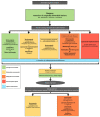Lomentospora prolificans: An Emerging Opportunistic Fungal Pathogen
- PMID: 35889036
- PMCID: PMC9316904
- DOI: 10.3390/microorganisms10071317
Lomentospora prolificans: An Emerging Opportunistic Fungal Pathogen
Abstract
Lomentospora prolificans is an emerging opportunistic pathogen that primarily affects immunocompromised individuals leading to disseminated disease with high mortality rates while also causing infections in healthy populations. Successful recovery from infection is difficult due to high rates of intrinsic resistance to antifungals. Rapid and readily available diagnostic methods, aggressive surgical debridement wherever appropriate, and effective and timely antifungal treatment are the pillars for successful management. Future research will need to clarify the environmental niche of the fungus, further investigate the pathophysiology of infection and define species-specific therapeutic targets.
Keywords: Lomentospora prolificans; fungal infection; immunosuppression; opportunistic.
Conflict of interest statement
The authors declare no conflict of interest.
Figures


References
-
- Hennebert Bj Desai B.g. Lomentospora prolificans, a new hyphomycete from greenhouse soil. Mycotaxon. 1974;1:45–50.
-
- Malloch D., Salkin I. A new species of Scedosporium associated with osteomyelitis in humans [Scedosporium inglatum, isolated from a bone biopsy] Mycotaxon. 1984;21:247–255.
-
- Gueho E. Taxonomy of the medical species of Pseudallescheria and Scedosporium. J. Mycol. Med. 1991;118:3–9.
-
- Kwon-Chung K.J., Bennett J.E. Medical Mycology. Lea & Febiger; Malvern, PA, USA: 1992. Pseudallescheriasis and Scedosporium infection; pp. 678–694.
Publication types
LinkOut - more resources
Full Text Sources

